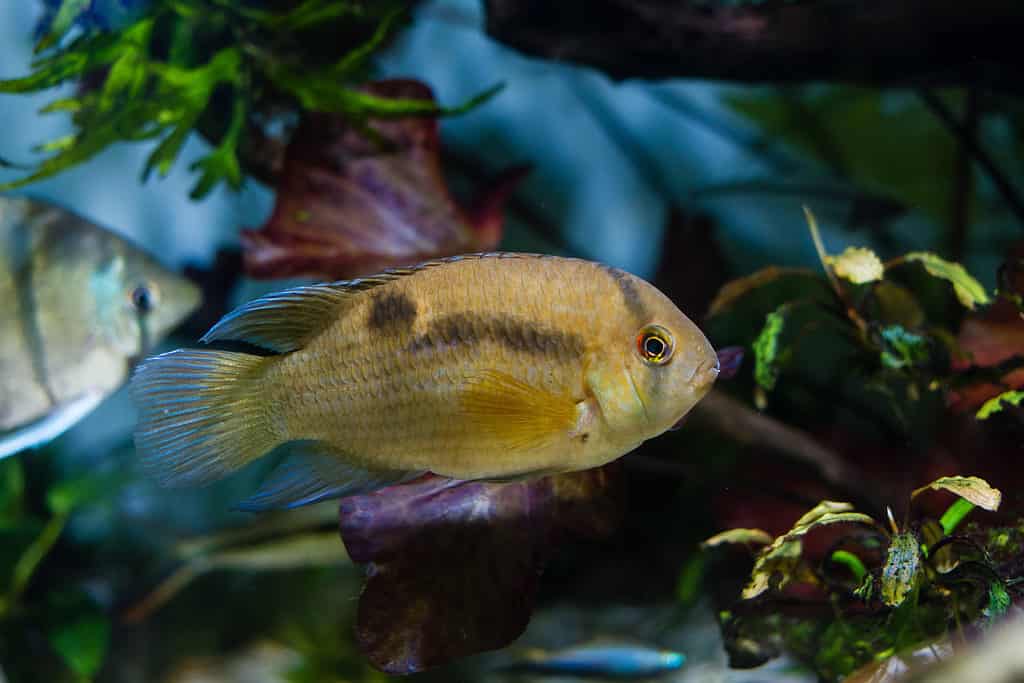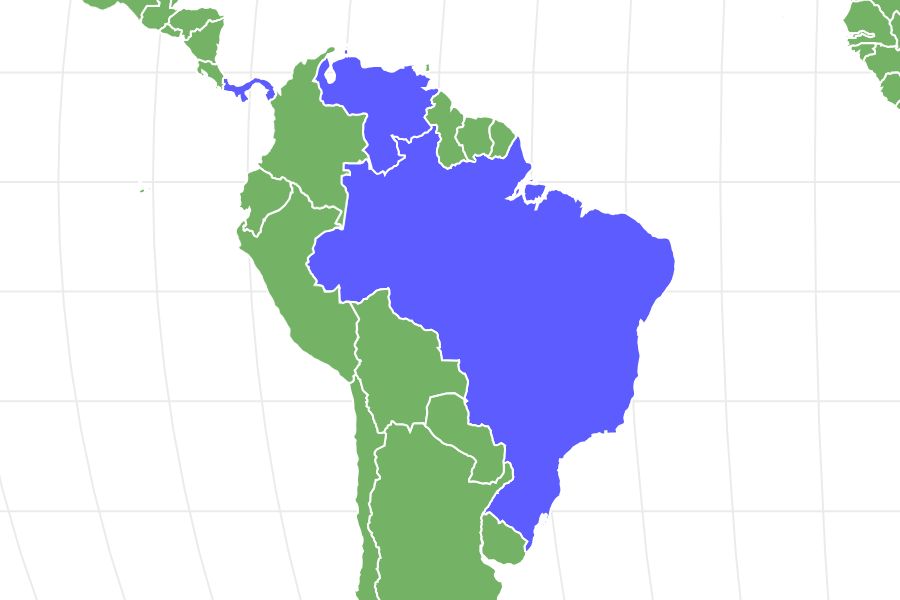Keyhole Cichlid
Cleithracara maronii
When these fish feel stressed, their skin color will change from yellow-cream to brown.
Advertisement
Keyhole Cichlid Facts
- Main Prey
- Small fish, crustaceans and insects
- Name Of Young
- Fry
- Fun Fact
- When these fish feel stressed, their skin color will change from yellow-cream to brown.
- Biggest Threat
- habitat destruction and pollution
View all of the Keyhole Cichlid images!
Native to South America, keyhole cichlids are freshwater fish that live in slow-moving bodies of water covered in thick vegetation. They are primarily found in coastal streams, tributaries, and river basins. Venezuela’s lower Orinoco basin is home to where many of the keyhole cichlids live.
Keyhole Cichlids Facts
- Natives of Venezuela have called the keyhole cichlid various names, including Prapra, Pakawété boko olékopo, Awalipa, and Awifi.
- This speedy fish can swim at a pace of at least 60 miles per hour.
- When these fish feel stressed, their skin color will change from yellow-cream to brown.
- These fish kiss one another during courting.
- If they feel threatened, these fish can blend in with their surroundings by changing their color.
Classification and Scientific Name
Scientifically known as Cleithracara maronii, the Keyhole cichlid belongs to the family Cichlidae. Their name originates from the distinctive keyhole pattern on their body.
Keyhole Cichlid Appearance

Different keyhole fish species have different fin colors.
©chonlasub woravichan/Shutterstock.com
The most distinctive feature of this fish is the black keyhole mark on its upper flank. This secondary marking is located on the fish’s face, which displays a black vertical line that extends across the head and passes through the eye.
Their body consists of yellow-cream colored scales; however, different keyhole fish species have different fin colors. Additionally, with age, keyhole cichlids’ coloring lightens.
The dorsal and anal fins of keyhole cichlids are long and slender. They differ from other cichlid species by having rounded foreheads and oval-shaped bodies.
Keyhole Cichlid Distribution, Population, and Habitat
The species of this fish is found in Central and South America. It has a wide distribution, ranging from the Atlantic coast of Panama to the Amazon River basin in Brazil. It is a freshwater fish that inhabits slow-moving rivers, streams, and lakes. The population of the keyhole cichlid fish is considered stable; unfortunately, it’s threatened by habitat destruction and pollution. This fish species prefers to live in shallow, murky waters in areas with plenty of vegetation. It is a carnivore that feeds on insects, crustaceans, and small fish.
Keyhole Cichlid Predators and Prey
In the wild, the keyhole cichlid predators include larger fish, such as the piranha and birds of prey. Other potential predators include snakes, caimans, and other aquatic animals.
In addition, the keyhole cichlid is also preyed upon by other fish, such as the oscar and the discus. To protect itself against certain predators, the keyhole cichlid will hide in rocks and crevices and use its bright colors to blend in with its surroundings.
Reproduction and Lifespan
These fish reproduce by laying eggs on a flat rock or a hard surface. The male is responsible for providing a suitable location so the female can lay her eggs. The female will lay up to 500 eggs, which the male guards until these eggs hatch. During this time, the male will fan the eggs with his fins to keep these eggs oxygenated and free of debris.
The eggs will then hatch within a few days, and both parents will take care of the young fish (now called fry) until they can swim and look for food. After this stage, the male will no longer guard the fry, and the female will take over caring for them.
The lifespan of the keyhole cichlid is usually between 5-10 years. However, they are a hardy species and can live longer with proper care.
Keyhole Cichlid in Fishing and Cooking
This sought-after fish is known to put up a good fight, so it is essential to use the correct tools and bait to catch these intelligent fish. The keyhole cichlid has a taste for white bread, worms, shrimp, and minnows; use these ingredients as bait. And, of course, invest in a hardy spinning reel, as these fish come with great force.
Fishing the keyhole cichlid is a great way to enjoy the outdoors and experience the thrill of the catch. This colorful fish is a popular choice for freshwater anglers and can be found in many parts of the world.
As for cooking this tasty fish, it’s a great staple to a delicious meal. This fish is an excellent option for those looking for a unique flavor and texture. Not only is it a healthy choice, but it is also easy to prepare. With just a few simple ingredients such as prawns, spinach, peas, garlic, juice of an orange, and spirulina powder, you can create a flavorful dish that will be sure to please. If you are looking for something new and exciting, add this fish to your culinary repertoire.
Keyhole Cichlid Population
The population of this fish found in the wild is stable, as It is not considered to be threatened or endangered. Furthermore, this popular aquarium fish is a peaceful species well-suited to a community tank, making these fish a popular choice for aquarists.
Related Animals
View all 77 animals that start with KKeyhole Cichlid FAQs (Frequently Asked Questions)
What is the scientific name for keyhole cichlid fish?
Keyhole cichlids are scientifically known as Cleithracara maronii and belong to the family Cichlidae.
What is the keyhole cichlids' most distinctive feature?
The most distinctive feature of the keyhole cichlid is the black keyhole mark on its upper flank. This secondary marking is located on the fish’s face, which displays a black vertical line that extends across the head and passes through the eye.
Where can the keyhole cichlid fish species be found?
The species of this fish is found in Central and South America.
What do keyhole cichlid fish eat?
It is a carnivore that feeds on insects, crustaceans, and small fish.
Thank you for reading! Have some feedback for us? Contact the AZ Animals editorial team.
Sources
- meethepet, Available here: https://meethepet.com/keyhole-cichlid/
- aquatic community, Available here: https://www.aquaticcommunity.com/cichlid/keyhole.php
- aquarium fish city, Available here: https://aquariumfishcity.com/keyhole-cichlid/

















